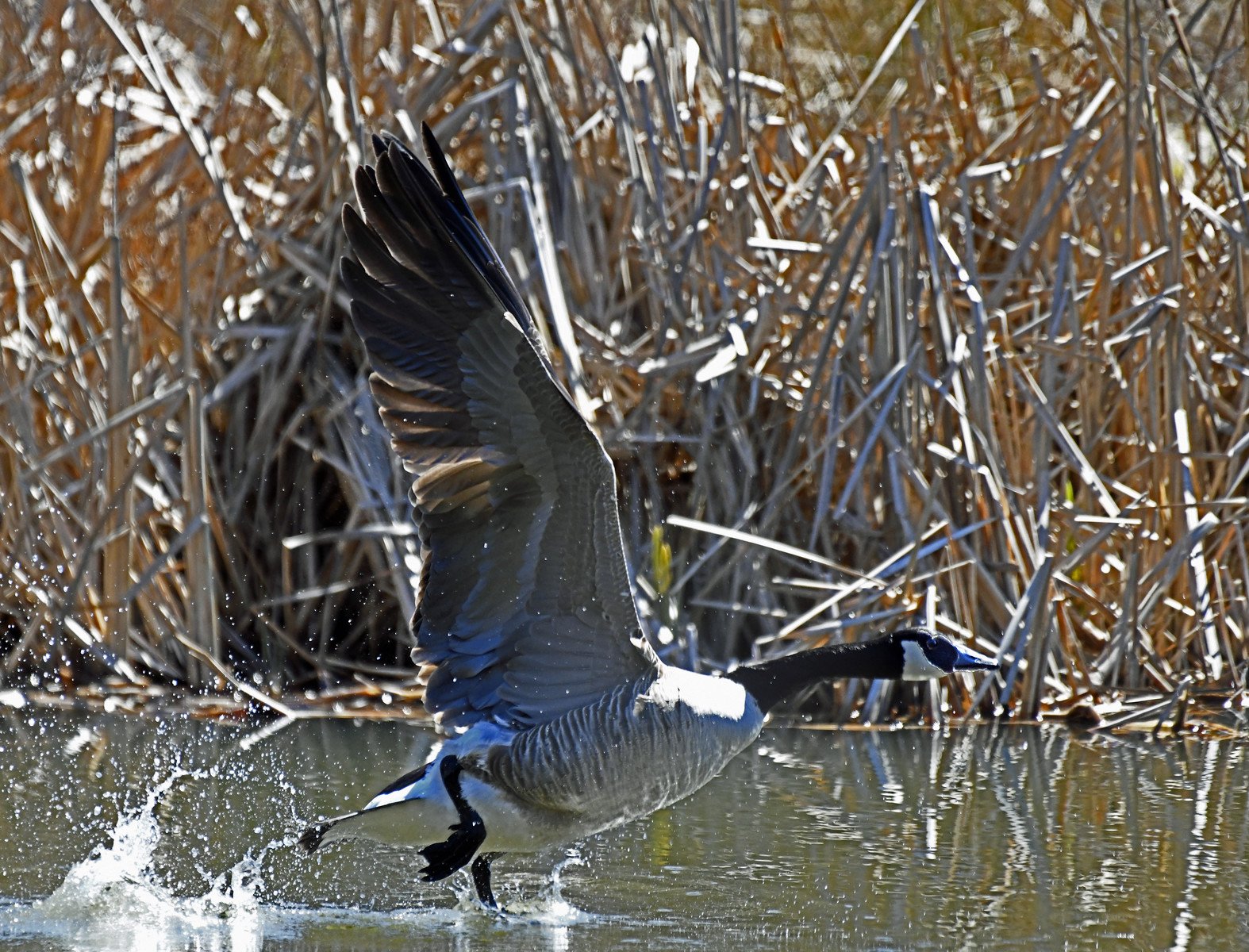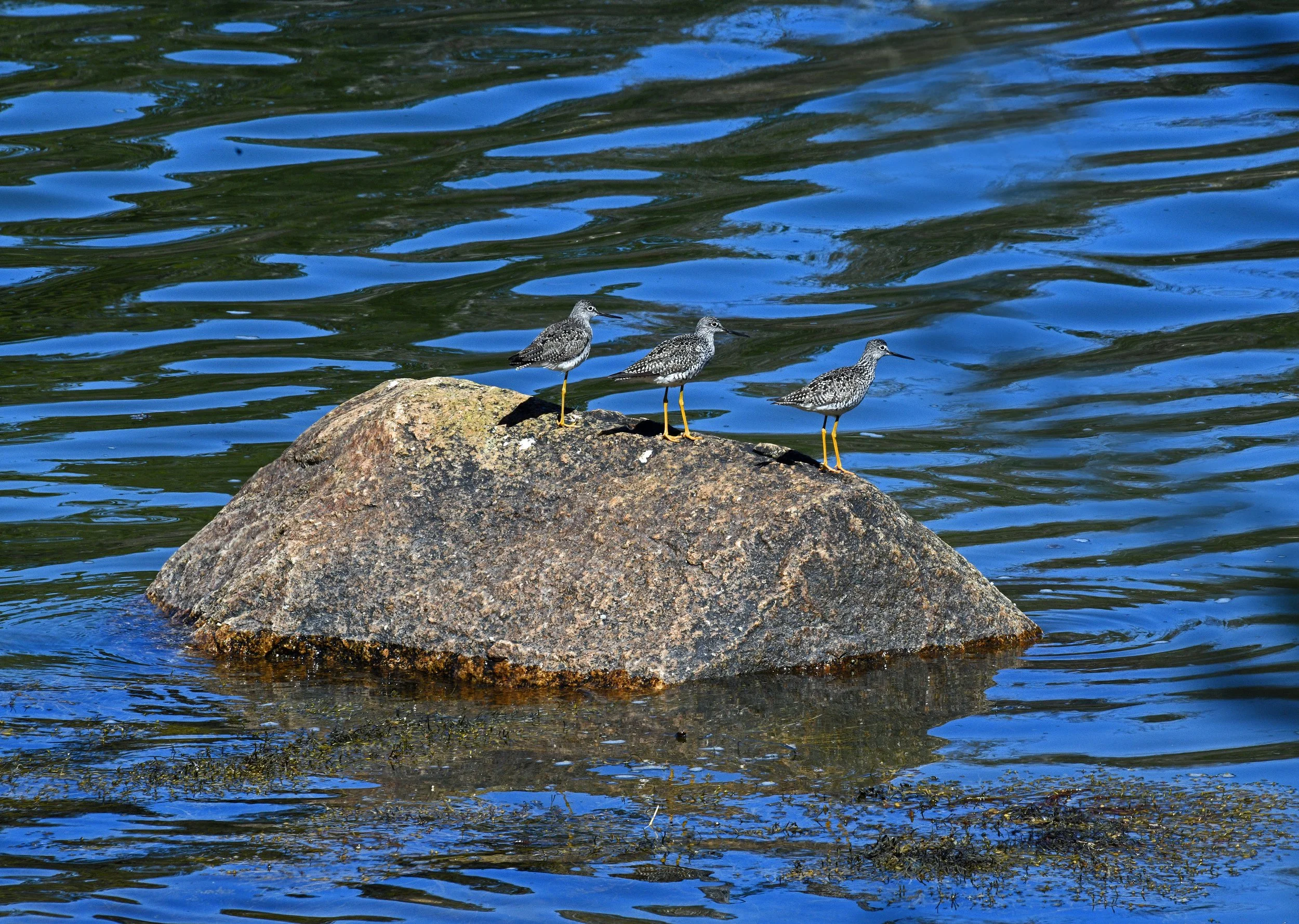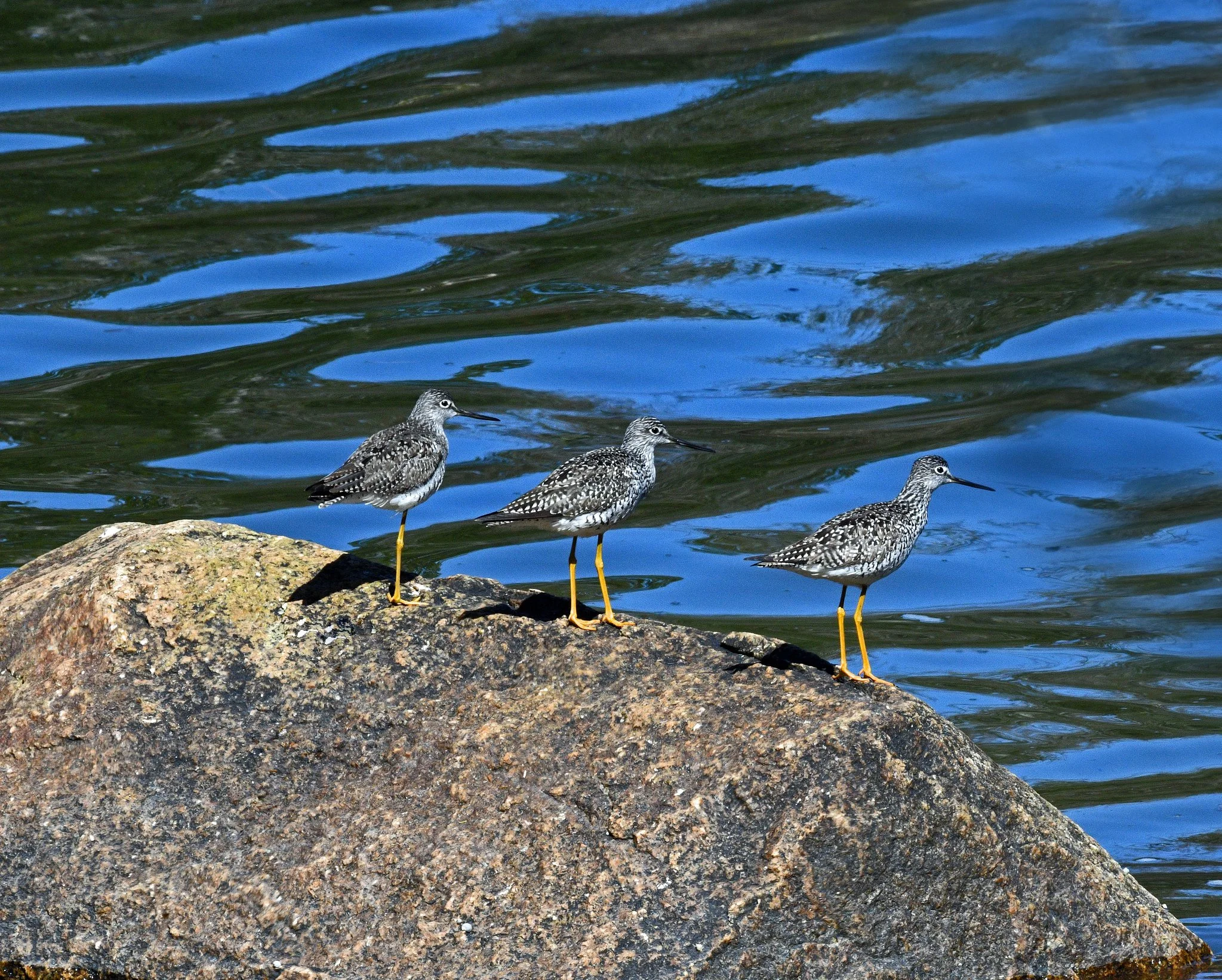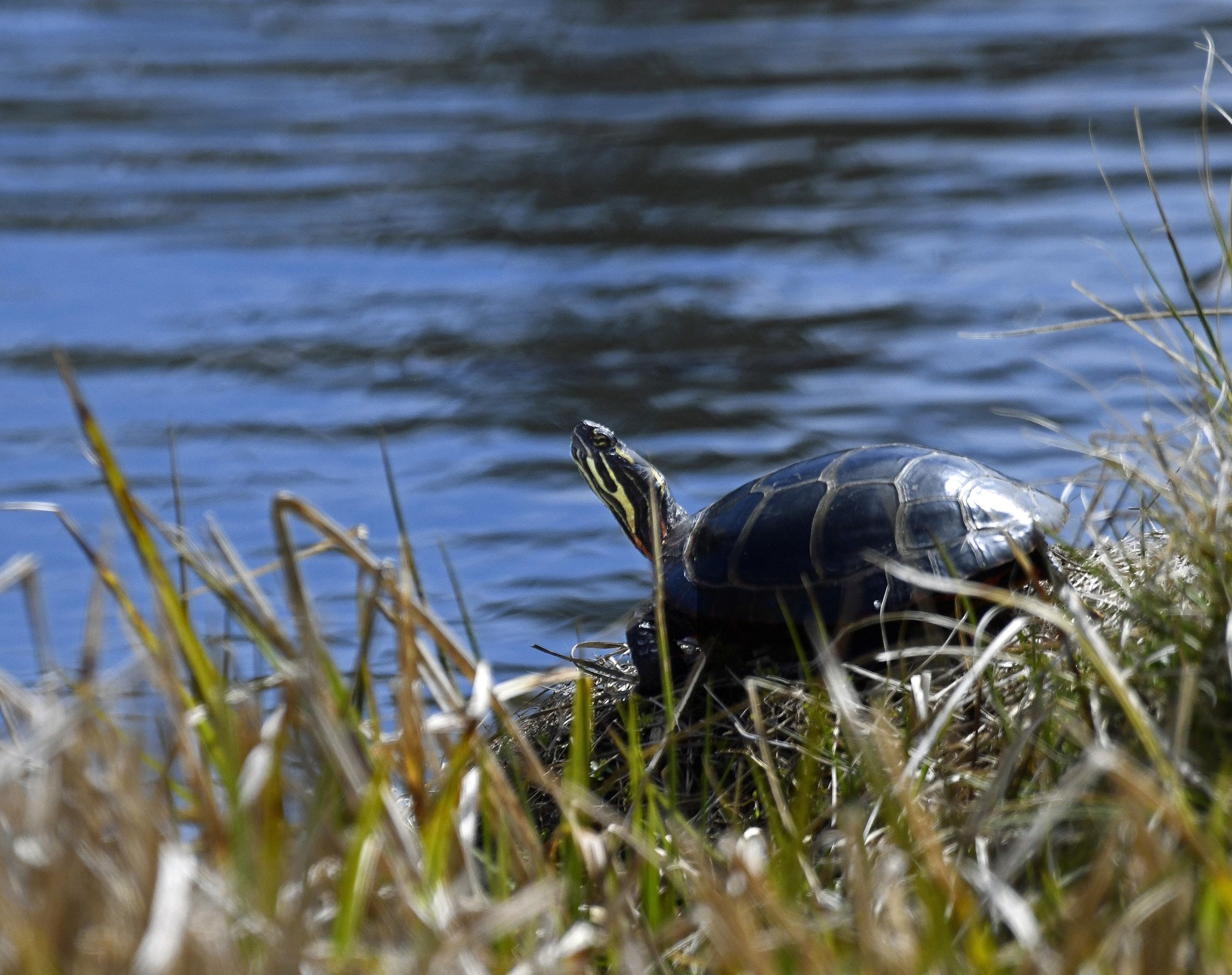This image of a towering Maine pine tree appears in my monthly column in the current Ellsworth American. To read the column about Maine’s unique Arbor Week opportunities relating to planting and celebrating trees and other flora, click here: http://www.5backroad.com/montly-column
Greater yellowlegs (Tringa melanoleuca) and their half-sized cousins, the lesser yellowlegs (Tringa flavipes), are arriving here. These sandpipers are easy to identify as yellowlegs at the beach, when they’re using their disproportionately long and disturbingly yellow limbs to wade in the shallows. But greater yellowlegs pipers, such as this fellow, also work the marshes alone, where it’s a different story.
It’s not that greater yellowlegs are hard to identify in marshes; it’s that they’re almost impossible to SEE when they stand still there. Their yellow legs can seem to be dead vegetation and their neutrally-checkered bodies make their familiar shapes dissolve into the complex backgrounds.
Fortunately, greater yellowlegs seem to find it impossible to stand still when they’re secretly watching you looking for them. They’ll often teeter-totter in place, flit nervously, or fly off fast and low. That’s when you’ll notice them most.
Nonetheless, when you’re slowly sweeping a big lens along a marsh edge and your viewfinder suddenly finds a yellowlegs that’s standing still and secretly watching you, it can be one of those slightly-creepy-but-delightful discoveries. (Images taken in Brooklin, Maine, on May 5, 2024.)
Here’s our monthly photographic record of this iconic view from Brooklin’s Amen Ridge, with a semi-hidden bonus: a bald eagle hurrying home that you might have missed on your first glance.
As you probably know, this scene is one of the views to the east from our peninsula across Blue Hill and Jericho Bays to the western mountains on Mount Desert Island. MDI is Maine’s largest island and is accessible by bridge. It contains most of Acadia National Park and Bar Harbor, MDI’s largest town. (Image taken in Brooklin, Maine, on May 3, 2024)
American red squirrels, also known as pine squirrels, are easing out of their grayish winter coats and slipping into their reddish summer jackets here. They soon will be mostly red with dark stripes along their sides, sort of the rodent version of racing stripes.
This one also has something going on near the shoulders. I wonder if those patches might be a case of mange from mites, which I’m told is not unusual in red and gray squirrels.
Nonetheless, this little fellow seemed chipper and normally nasty when cursing me out Saturday. Red squirrels (Tamiasciurus hudsonicus Erxleben) are one of our most unsociable, aggressive, and territorial mammals, notwithstanding their size. They usually don’t even tolerate their own mate or any other squirrel species in their territories, except when breeding.
Some of them will take food handouts from humans when they invade human territory, but when we invade their territory, most get angry and sputter, growl, and deliver curses in squirrelese. (Image taken in Brooklin, Maine, on May 4, 2024.)
Many forsythia flowers are peaking here now with bright yellow blooms that probably will last about two or three weeks. The bushes are in various shapes. The ones that have been allowed to grow without restraint often form waves of bright yellow that seem to be arriving like surf.
Those that are pruned often look like yellow explosions erupting unexpectedly. Some larger plants along the sides of structures often become huge yellow barriers.
As you probably know, the buds for the plant’s tiny four-petaled yellow flowers are on last year’s branches; they bloom before the leaf buds on the new wood. When the flowers fall and the bush becomes fully leafed-out, forsythia becomes a dense green bush.
The plant is native to China, but has been a favorite in the United States for many years. It was named after the Scottish horticulturist William Forsyth (1737-1804). (Images taken in Brooklin, Maine, on May 4, 2024.)
Naskeag Harbor was calm and reflective yesterday. The two moored fishing vessels taking their spring break there added just the right touch for the peaceful mood. Below, you’ll see “Christopher-Devin III,” a Nova Scotia design lobster boat (a “Novi”). Her scallop fishing mast and other gear haven’t been removed yet, but will be gone by the summer lobster season.
As you’ll see below, “Tarrfish,” a classic Maine lobster boat, has had her scalloping gear removed and been cleaned up a bit after her winter season’s scallop dredging (“dragging”) and diving by her captain and owner, David Tarr.
(Images taken in Brooklin, Maine, on May 4, 2024.)
It’s been a week of great concern, brief relief, and then worrisome confusion at the Osprey Nest, home of Ozzie and Harriet. I watched the nest on Sunday through Thursday, sometimes multiple times a day. I neither saw nor heard Ozzie or Harriet on any of those days.
The nest looked abandoned, but it is deep and I can’t peer into it from my distant perspective, which is through a long lens stuck out of a car parked at the edge of a field. I was beginning to panic, but there always is the hope that I was just visiting the right place at the wrong times.
Then came sunny yesterday. When I arrived, the nest still looked abandoned. I decided to hunker down and spend some serious time there. Nothing relevant happened for 52 minutes. Then, there was a blur to the right: It was Ozzie! He flew onto a lower branch of an old birch tree near his home tree. And he had a good-sized fish in his talons!
Ozzie began to tear apart and eat the fish’s head, which is his usual starting point. The nest remained inactive and silent while he ate gustily. After more than 15 minutes of tearing and gulping, Ozzie stopped eating, defecated, looked at the nest and started calling with a series of loud, high-pitched Osprey “Cheeps.” And calling, and calling. This went on for more than 10 minutes without a response. And, of course, by then I’m thinking, “Oh God, she’s gone; Harriet’s jilted him or she’s dead!”
Then, there was a “Cheep-Cheep” from the nest that still looked empty. But, no. Soon, Harriet’s head appeared over the edge of the nest, looking down at Ozzie. When that happened, Ozzie flew to the nest, delivered lunch, and tried unsuccessfully to copulate with his mate. He then flew off over the Cove and Harriet ate hungrily without comment. The scene happened so fast that I couldn’t hand-focus my big lens well. Here’s Ozzie delivering the fish:
I don’t know what to make of this.
Harriet’s lying low in the nest for extended periods is consistent with egg-laying or egg-brooding behavior. But, it’s very early for that, based on past years at the nest and a little research. She didn’t appear injured, but then I haven’t seen her fly for over a week. I wonder if it’s somehow related to the higher temperatures and more violent storms brought on by Climate Change. Let’s hope that there’s a better explanation by next Saturday. (Images taken in Brooklin, Maine, on May 3, 2024.)
This is the reaction of a molting white-tailed doe that was surprised at seeing me in yesterday’s light rain:
On seeing this (for some weird, inexplicable reason), I thought of what was once famously said by Joe Louis, the legendary heavyweight boxer of the 20th Century, before a fight: “He can run, but he can’t hide.”
On the other hand, speaking of inappropriate quotes, this hiding doe’s nearby companion might have been inspired by Captain John Parker’s order to America’s first troops at Lexington Green: “Stand your ground!”:
(Images taken in Brooklin, Maine, on May 2, 2024.)
Back in the day, some of us teenage boys would get preened up and congregate on a street corner or other place where people were going by to ogle and comment on the passing young women. There even was a popular song about “Standing on the corner, watching all the girls go by.” We thought that we were irresistible and never wondered why most of the girls never gave us a second thought. Dignity seems to develop late, if at all, in males of all kinds.
Well, take a look at these four Toms yesterday doing the wild turkey strut-and-gobble shuffle:
And, this was all about one, that’s 1, I say ONE passing hen. And, she also never gave the Toms a second thought:
Pity the poor Toms who are compelled by nature to take the initiative to propagate the species. Researchers point out that these birds have to exert a tremendous effort to flex the musculature system over most of their body and keep it in peak tension for extended periods to do the strut-and-gobble shuffle. (Images taken in Brooklin, Maine, on May 1, 2024.)
April, the bringer of Spring, this year also brought us a significant snowstorm; torrential and damaging rain-and-wind storms; a historic solar eclipse; a white full moon named Pink; the end of the scallop fishing season; the return of fascinating flora and fauna, and some tingle-inducing sunny days. We, of course, begin with sunny days and their reflections.
In her first week, April brought forth a significant snow storm and all the beauty and trouble that go with such events. The snow flakes soon were followed by more damaging torrential rain and high winds.
The precipitation swelled the streams to flood levels and the winds brought down trees, which brought down power lines, which brought out power company trucks and road graders on our country lanes.
As for our flora, our earliest flowering plant is the beautiful (unfairly maligned) skunk cabbage. (It doesn’t emit bad odors unless crushed.) It didn’t seem to be bothered by being under snow or under water, probably because it generates its own heat and hides its flowers in pointed pixy hats (“spathes”).
Our trees weren’t leafed out, but that made it easier to see the arthritic curvatures of old apple trees, the fuzzy blooms of red maples, and the cats’ paws of pussy willows.
Blue Quaker ladies and yellow daffodils often kept company in support of Ukraine. On a larger scale, eager masses of forsythia were welcomed by the waving buds and pom-poms of star magnolias.
In the formative stage, the arrow arum had not yet grown its massive arrow heads and the ferns had not grown out of their fiddleheads.
On the wild side, the white-tailed deer had some frosty-flaked breakfasts, the migrating birds began to return, and the painted turtles rose from their murky beds to bask in the sun. Of special interest was the return of a pair of ospreys to a nest that we monitor yearly.
On the working waterfront, scallop-fishing season officially ended in April and the dredging (“dragging”) booms, masts and netted dredges (“drags”) were removed from the fishing vessels and stored. On the recreational waterfront, fleets of lazy boats continued to snore in their winter sheds as their mooring gear braved the elements.
As to things lunar, April was spectacular. The April 8 moon created a historic total eclipse of the sun for much of central Maine and a 97 percent eclipse (all but a radiating sliver) for us here on the coast. We were able to see and photograph the sun and interfering moon through solar-filtered (black polymer) glasses and camera attachments
Finally, later in the month, the April full moon rose on a chilly evening. It’s called the Pink Moon, one of the names that Native Americans gave it because it appears when pink phlox does (so the say). Nonetheless, it was a white moon and not nearly as spectacular as the black (new) moon that dared to hide the sun. But what was poor April to do? She had used up most of her magic by then in a bravura performance.
(All images above were taken in Down East Maine during April 2024.)
Our star magnolia buds are bursting hourly into beautiful, free-form flowers like this:
The wind sometimes tosses the sun-radiating petals in a way that creates a pom-pom effect, with the whole bush wildly waving cheers.
The buds look like large pussy willow catkins at first, and then they burst and the flowwers unfurl out:
The plants (Magnolia stellata) are among the first large plants to flower in the spring. As with many of our more outrageous flowering plants, star magnolias are natives to Japan. They reportedly were introduced in the United States during the difficult 1860s. (Images taken in Brooklin, Maine, on April 29, 2024.)
Here’s one of our earliest migrators. He’s an irrepressible Eastern phoebe (Sayornes phoebe). And, as the saying almost goes, the early bird gets the bug. He’s one of a pair that I first saw last week. (Sex assumed for narration; only phoebes can tell their males from females and both sexes sing.)
Note that this little phoebe is all slimmed out and eager after just having caught his breakfast. (Is that a grub?) However, his nearby mate remained puffed up and kept a wary – but not alarmed – eye on me:
(It was cold, she apparently wasn’t ready to use up energy needlessly, and I was a good distance away with a 500mm lens. .)
These two are “flycatchers,” a group of birds that have the amazing ability to catch flying insects on the wing. Phoebes often sit upright on a twig and bob their tails while identifying themselves with a very raspy “FEEE-BEEE” song to make sure that we at least identify their species correctly. They’re not shy; they often build their nests on or near human residences and under bridges. (Images taken in Brooklin, Maine, on April 25, 2024.)
It’s spring break time for the fishermen around here. The masts and booms for scallop dredging (“dragging”) mostly have been removed and clean-up time has arrived. Compare this image of Fishing Vessel “Tarrfish” as she looked last week, with her dragging self at the end of February:
The Maine scallop dragging season officially ended March 27 and the scallop diving season ended April 20. Note that “Tarrfish” still has her international diving boat flag up for April diving. Her owner and captain, David Tarr, is one of the few hardy divers in Maine who don a wet suit and air tank and hand-harvest the more expensive “divers’ scallops” from the sea bottom during winter.
Summer lobstering is next. (Images taken in Brooklin, Maine, on April 24 and February 27, 2024.)
All seemed to have gone well this week.
From what I’ve seen, during the breeding season, mature female ospreys usually don’t hunt for themselves. They eat fish brought to the family nest by their wide-ranging mates. They spend most of their time on that nest or on a nearby perch within sight of the nest, waiting for their mate to bring home dinner and/or turn the event into a conjugal visit.
When alone and hungry, breeding females often engage in what is called “begging,” a loud and high-itched series of short pleadings. When begging, they sometimes also shake their bodies like nestlings that want to be fed. There seems to be a good correlation between this activity and hunger, but there also are indications that begging can relate to the urge to mate (a process in which timing can be important).
Above, you see Harriet begging this week. She was in her favorite old birch near the nest and Ozzie was nowhere in sight. When Ozzie shows up with a fish, he usually goes directly to the nest and drops it there, even if Harriet is elsewhere. When he shows up without food and Harriet is perched near the nest, he has at times perched near her and waited for her to return to the nest with him:
And then, they usually copulate at this time of year. (Images taken in Brooklin, Maine, on April 23 and 25, 2024.)
Happy Arbor Day for those who celebrate the federally-designated day and for those in the numerous states that have designated the last Friday in April as the day to celebrate (and preferably plant) trees. (“Arbor” derives from the Latin word for tree and, of course, tress are among the world’s most important resources.)
However, Maine, the Pine Tree State that contains many trees, has chosen to postpone the event to May for reasons that I’ll probably discuss in my May newspaper column. Nonetheless, let’s now have a small celebration of the attractive red maple tree flower clusters that are appearing.
Red maples (Acer rubrum) can produce all female flowers, all male flowers, and a little of each on a tree, and they all appear in early spring before the trees’ leaves sprout. The female blossoms, such as these shown here, have stigmas extending beyond the petals to catch pollen from the male flowers:
The males have long stamens covered with yellowish pollen, as shown below:
That pollen is transported by the wind to the female stamens and elsewhere as many sensitive eyes and noses are finding out lately. (Images taken in Brooklin, Maine, on April 25, 2024.)
Sandpipers are once again bringing their fascinating frenzies back to our waters’ edges. Here you see what appears to be a trio of Lesser Yellowlegs (Tringa flavipes) resting in Great Cove, perhaps after a long flight.
They’re smaller versions of – you guessed it – Greater Yellowlegs, with slightly shorter and (sometimes) straighter beaks than their cousins. However, the two species are difficult to identify when they are not intermingled and I’m guessing at these because they appeared small.
The Lessers are also the “fewers” compared to the Greaters. The smaller versions are listed as a Species of Special Concern in Maine. They were hunted extensively in the 19th Century and served as popular tasty tidbits then. They apparently never recovered to their original numbers. Let’s hope a few keep coming back here. (Images taken in Brooklin, Maine, on April 23, 2024.)
The April full moon rose here yesterday evening out of the east-southeast like a slow spotlight searching for us through the spruce trees surrounding our house.
It eventually found us as it rose above the woods and over Great Cove. It was soaring about 247,555 miles away from Earth, which is a little farther than the average of 238,900 miles, according to lunar reports.
The April full moon is called the “Pink Moon.” That’s the name reportedly given to it by some eastern Native American tribes because its rising coincided with the blooming of pink wildflowers, according to The Old Farmers' Almanac. The Maine Farmers' Almanac reportedly was first to identify those flowers as herb moss creeping phlox (Phlox subulate). (Images taken in Brooklin, Maine, on April 23, 2024.)
You never know what you’re going to find around here. This small, stylish structure recently appeared in a field a mile or so down the road from us and had me wondering whether elves were entering our real estate market.
Then, a new little couple moved into that place and turned out to be very friendly, but with a lot of face hair (which isn’t unusual in Maine). What is unusual, however, is that they’re a pair of miniature donkeys, a type of good neighbor that I didn’t know existed until recently. The donkeys are named Grommit and Wallace and they’re pets:
From what I read, these animals are a distinct breed of donkey that originated in Sardinia and Sicily. They’re strong for their size, which usually is about three feet tall and 200-450 pounds in weight. They historically walked in circles to turn grain-grinding stones and transported supplies in rough terrain. They’ve apparently become popular pets in the U.S., although I doubt whether many apartments would allow them. (Images taken in Brooklin, Maine, on April 21 and 22, 2024.)
Here you see Mount Desert Island, Maine’s largest Island, making its own weather again. When moving air encounters the mountains on MDI, it swoops up, cools down, and often condenses out water vapor that forms a crown of clouds.
Frequently, it’s pillowing cumulus clouds, such as those here, that are formed there across Blue Hill and Jericho Bays. (Image taken in Brooklin, Maine, on April 21, 2024.)
Our Eastern painted turtles (Chrysemys picta picta) have been rising from their murky winter hideaways and trying to soak up some sun:
I’m guessing that this one is a male because of its relatively long and substantial tail. Female PTs, although larger in total body than males, have shorter, stubbier tails to facilitate mating.
Being cold-blooded (“ectothermic”), the turtles’ body temperatures are determined by their environment. They must maintain an internal temperature of between 63 and 73 degrees (F) to be active, according to reports. Basking in the sun, especially on a surface that warms up below them, is a principal way that PTs and other cold-blooded animals can maintain enough heat to be active.
In PTs, the heat that they absorb increases their metabolism, helps them digest, and induces males to produce sperm, researchers have found. The sunlight reportedly also strengthens their shells, attacks algae that can cause infection, and enables turtles to produce vitamin D 3, which is needed for the absorption of calcium used in structural growth. (Images taken in Brooklin, Maine, on April 19, 2024.)































































































